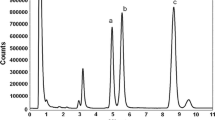Abstract
The Solanaceae has been one of the more important families in providing useful plants for humankind. By far the greatest number of these comes from tropical America, white potatoes, tomatoes and chili peppers being the best known. In recent years the fruits of two others, the tree tomato (Cyphomandra betacea) and the pepino (Solanum muricatum) have begun to appear in our markets, both imported from New Zealand where they had been introduced from tropical America. To my thinking two other members of the family, the naranjilla (S. quitoense) and the cocona (S. sessiliflorum), are equal or superior to the last two, but they have yet to reach markets outside of Latin America. These species, both placed in the section Lasiocarpa of Solanum, are the subjects of this paper.
Access this chapter
Tax calculation will be finalised at checkout
Purchases are for personal use only
Preview
Unable to display preview. Download preview PDF.
Similar content being viewed by others
References
Anonymous, 1984, “Memorias de la primera conferencia intemacional de naranjilla,” Instituto Nacional de Investigaciones Agropecuarias, Quito, Ecuador.
Clement, C., 1989, A center of crop diversity in western Amazonia, BioSciences 39:624–630.
Heiser, C., 1971, Notes on some species of Solarium (sect. Leptostemonum) in Latin America, Baileya 18:59–65.
Heiser, C., 1972, The relationship of the naranjilla, Solanum quitoense, Biotropica 4:77–84.
Heiser, C., 1985, “Of Plants and People,” University of Oklahoma Press, Norman.
Heiser, C., 1989, Artificial hybrids in Solarium sect. Lasiocarpa, Syst. Bot. 14:3–6.
Ledin, R., 1952, The naranjilla (Solarium quitoense Lam.), Proc. Florida State Hort. Soc. 65:187–190.
Miller, C., 1969, Cytokinin production by mycorrhizal fungi, in: “Proceedings of the first North American Conference on Mycorrhizae,” Misc. Publ. 1189, U.S. Dept. Agric., Washington, D.C.
National Research Council, 1975, “Underexploited tropical plants with promising economic value,” National Academy of Sciences, Washington, D.C.
Patino, V., 1962, Edible fruits of Solatium in South American historic and geographic references, Bot. Mus. Leaf., Harvard Univ. 19:215–234.
Romero-Castaneda, R., 1961, El lulo: una fructa de importancia economica, Agricultural Tropical 17:214–218.
Salick, J., 1989, Cocona (Solanum sessiliflorum) production and breeding potentials of the peach-tomato, in: “New Crops for Food and Industry,” Wickens, G. and Day, P., eds., Chapman and Hall, London.
Schultes, R. and Romero-Castaneda, R., 1962, Edible fruits of Solanum in Colombia, Bot. Mus. Leaf., Harvard Univ. 19:235–286.
Torre, R. and Camacho, S., 1981, Campesino fitomejorador de naranjilla, Carta de Frutales no. 14, Instituto Nacional de Investigaciones Agropecuarias, Quito, Ecuador.
Whalen, M. and Caruso, E., 1983, Phylogeny of Solanum sect. Lasiocarpa (Solanaceae): Confluence of morphological and molecular data, Syst. Bot. 8:369–380.
Whalen, M., Costich, D. and Heiser, C., 1981, Taxonomy of Solanum section Lasiocarpa, GentesHerb. 12:41–129.
Author information
Authors and Affiliations
Editor information
Editors and Affiliations
Rights and permissions
Copyright information
© 1993 Springer Science+Business Media New York
About this chapter
Cite this chapter
Heiser, C.B. (1993). The Naranjilla (Solanum quitoense), The Cocona (Solanum sessiliflorum) and Their Hybrid. In: Gustafson, J.P., Appels, R., Raven, P. (eds) Gene Conservation and Exploitation. Stadler Genetics Symposia Series. Springer, Boston, MA. https://doi.org/10.1007/978-1-4899-1136-0_3
Download citation
DOI: https://doi.org/10.1007/978-1-4899-1136-0_3
Publisher Name: Springer, Boston, MA
Print ISBN: 978-1-4899-1138-4
Online ISBN: 978-1-4899-1136-0
eBook Packages: Springer Book Archive




